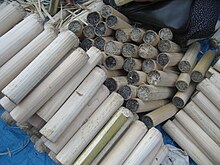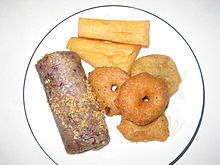Sticky rice in bamboo
This article needs additional citations for verification. (February 2013) |
 Burmese sticky rice in bamboo | |
| Region or state | Southeast Asia |
|---|---|
| Associated national cuisine | Burmese, Cambodian, Lao, Thai, Vietnamese |
| Main ingredients | Glutinous rice, hollow bamboo tubes |
| Similar dishes | Lemang, Daetong-bap |
Sticky rice in bamboo is a common Southeast Asian dish consisting of sticky rice roasted inside specially prepared bamboo sections of different diameters and lengths. It is consumed both as a savory food and as a sweet dessert.
Names[]
The dish is known by various names throughout Southeast Asia, including paung din (ပေါင်းတင်း) or kauk hnyin kyi dauk (ကောက်ညှင်းကျည်တောက်) in Burmese, kralan (ក្រឡាន) in Khmer, and khao lam (ข้าวหลาม, pronounced [kʰâw lǎːm]; ເຂົ້າຫລາມ) in Lao and Thai and cơm lam in Vietnamese. In Thai, khao means rice and lam means the cooking process, which involves roasting the contents in prepared bamboo sections, while in Vietnamese cơm lam translates as "bamboo cooked rice".
In Malaysia and Indonesia, it known as lemang, which is typically eaten during Eid-ul-Fitr celebrations, where it can be eaten with rendang.
Variations[]
Cambodia[]

In Cambodia, sticky rice in bamboo is called kralan (ក្រឡាន). It is made by roasting a mixture of glutinous rice, black-eyed peas or beans, coconut milk, grated coconut and palm sugar in bamboo tubes over a fire[1] for around 90 minutes. Kralan is often prepared and eaten at Chinese and Khmer New Year.[2] According to archeological evidence, rice has been cooked in bamboo already by the Mon Khmer tribes and in Khmer Empire kralan was used as military rations, which has lead historian Dr. Michel Tranet to believe that the method of roasting sticky rice in bamboo tubes originated in Cambodia.[1] Thma Krae village in Kratie Province and Samrong Khnong village in Battambang Province have become well known for their sticky rice in bamboo.[3]
Myanmar (Burma)[]

Paung din (ပေါင်းတင်း) or kaukhnyin kyidauk (ကောက်ညှင်းကျည်တောက်) is another ready-to-eat portable form cooked in a segment of bamboo. When the bamboo is peeled off, a thin skin remains around the rice, and it also gives off a distinctive aroma.
Thailand[]

Khao lam uses sticky rice with red beans, sugar, grated coconut, and coconut milk. It can be prepared with white or dark purple (khao niao dam) varieties of glutinous rice. Sometimes described as a "cake", thick khao lam containers may have a filling of coconut custard in the center that is made from coconut cream, egg, and sugar. Khao lam can be consumed as savory food or dessert. It is a cultural food and is an OTOP[4] product. Moreover, Thai people present khao lam to monks to make merit. Further, it is gradually becoming a Thai tradition.
In the past, Thailand had innumerable bamboo trees. Thai people thought about the utility of using bamboo for cooking purposes. The ingredients of khao lam are glutinous rice, black beans, coconut milk, sugar and salt.[5] Moreover, taro or young coconut may be added.
Vietnam[]
In Vietnam, it is called cơm lam and found in the Northwest Mountainous Area. It originated when mountain people, such as the Tai peoples, would prepare for long journeys by pressing wet rice (cơm) with added salt, into bamboo tubes, and cooking.[6] Cơm lam is also served in Central Highlands food stalls with chicken.[7]
See also[]
- Daetong-bap
- Lemang
References[]
- ^ a b Taing, Rinit (21 February 2018). "Hard work put into roadside snack favourite kralan". The Phnom Penh Post. Retrieved 25 October 2019.
- ^ Nhem, Chea Bunly (22 May 2004). "Let Them Eat Cake". The Cambodia Daily. Retrieved 11 January 2009.
- ^ "Kralan on Kilometer 28". Khmer Times. 2 June 2016. Retrieved 16 November 2016.
- ^ ""ข้าวหลามปลาร้า" แซบสไตล์อีสาน สูตรเด็ดแม่แอ๊ด โอทอปนครปฐม". ASTV ผู้จัดการออนไลน์. Retrieved 2015-05-17.
- ^ "ข้าวหลาม อาหารจากภูมิปัญญาไทย". Sukhothai Thammathirat Open University. Retrieved 2015-05-17.
- ^ Anthropos Volume 99, Issue 1 Österreichische Leo-Gesellschaft, Görres-Gesellschaft, Anthropos Institute - 2004 "3.1 Cơm lam The Vietnamese still see the Tháy as people who eat cơm lam, muôi ông (in-bamboo-tube cooked [glutinous] rice and [who store] salt in bamboo tube). They believe, when one is in forest regions, one has to eat this type of com ..."
- ^ Vietweek, Thanh Nien News, Vietnam Youth Association Delicacy made in a bamboo stem - Visit the Central Highlands to discover spectacular sceneries and eat and drink like a mountain dweller June 8, 2012 print issue, June 16, 2012 web edition. "Anyone visiting the Central Highlands should try cơm lam (rice cooked in bamboo stems) and grilled chicken. It is a fascinating experience to eat the rice and chicken by dipping it in sesame and salt and drink rượu cần (a beer-like drink sipped through a long bamboo pipe from a jar) like the mountain people do. Cơm lam has its origins in the mountainous lifestyle when tribesmen made long journeys through the forest to work on mountain fields."
External links[]
| Wikimedia Commons has media related to Sticky rice in bamboo. |
- Glutinous rice dishes
- Burmese cuisine
- Cambodian cuisine
- Chinese New Year foods
- Lao cuisine
- Thai cuisine
- Vietnamese cuisine
- Foods containing coconut